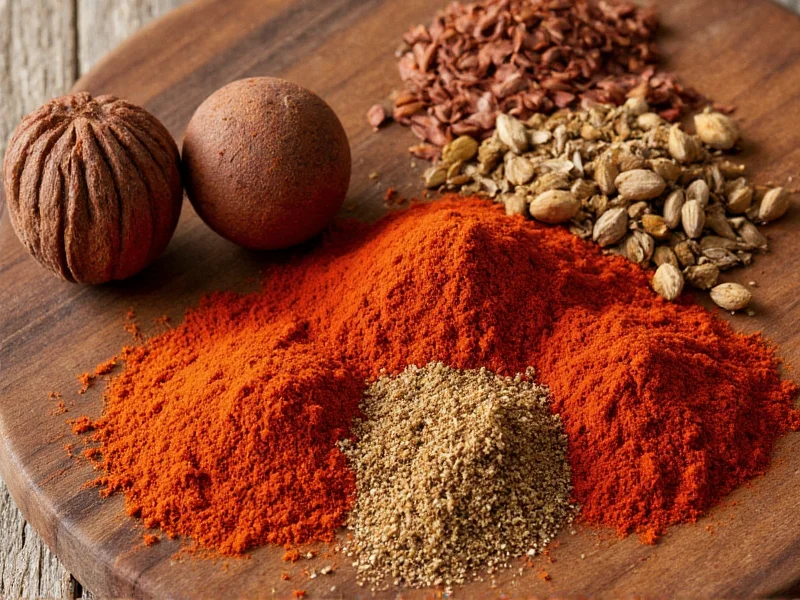What Exactly Is Mace Spice?
Mace comes from the same tropical evergreen tree (Myristica fragrans) as nutmeg, but represents a completely different part of the fruit. While nutmeg is the seed itself, mace is the lacy, crimson-red aril that envelops the seed. Harvesters carefully remove this membrane, then flatten and dry it until it transforms into brittle orange-yellow "blades" resembling small, crinkled petals.
The drying process intensifies mace's complex flavor profile, which combines warm notes of cinnamon and clove with subtle citrus undertones. This distinctive taste makes mace particularly valuable in recipes where a more refined spice presence is desired compared to nutmeg's stronger, earthier character.
Culinary Applications of Mace Spice
Chefs prize mace for its ability to enhance flavor complexity without overwhelming other ingredients. Unlike many spices that work primarily in either sweet or savory contexts, mace bridges both culinary realms effectively. Its delicate floral notes complement dairy-based sauces and custards beautifully, while its warm spice characteristics enhance meat dishes without dominating them.
| Dish Category | Recommended Mace Form | Usage Tips |
|---|---|---|
| Baked Goods | Ground | Add 1/8-1/4 tsp per cup of flour for cakes, cookies, and pastry |
| Custards & Creams | Whole blade | Infuse 1 blade in warm dairy, then remove before serving |
| Meat Stews | Ground | Add with other spices early in cooking for flavor development |
| Fish Dishes | Ground | Use sparingly (1/8 tsp) as finishing spice before serving |
| Pickling Brines | Whole blade | Add 1-2 blades per quart of brine for subtle complexity |
Mace in Historical and Traditional Medicine
Historically, mace spice uses extended far beyond the kitchen. Traditional medicine systems across Asia and Europe employed mace for various purposes, including digestive aid, pain relief, and respiratory support. Ancient Ayurvedic practitioners used mace to address digestive discomfort and improve circulation, while European herbalists incorporated it into remedies for toothaches and joint pain.
Modern research suggests mace contains compounds with potential antioxidant and anti-inflammatory properties, though scientific evidence remains limited. The spice's essential oils, particularly myristicin and elemicin, show promise in preliminary studies. However, these potential health benefits of mace spice should not be considered medical advice, and therapeutic applications require professional guidance.
Practical Kitchen Guidance for Mace Spice Uses
When incorporating mace into your cooking, understanding proper measurement and substitution ratios proves essential. Whole mace blades generally provide superior flavor compared to pre-ground versions, as the essential oils remain better preserved. For optimal results, toast whole blades lightly before grinding them fresh using a dedicated spice grinder or mortar and pestle.
Consider these practical tips for maximizing mace spice uses in your kitchen:
- Use ground mace in baking recipes where even distribution matters
- Add whole blades to simmering liquids for gradual flavor infusion
- Store mace in an airtight container away from light and heat
- Grind only what you need for immediate use to preserve volatile oils
- Pair mace with complementary spices like cinnamon, cloves, and allspice
Mace vs. Nutmeg: Understanding the Differences
While mace and nutmeg originate from the same fruit, their flavor profiles and culinary applications differ significantly. Mace offers a more delicate, floral character with subtle citrus notes, while nutmeg delivers a stronger, earthier warmth. This distinction makes mace particularly valuable in dishes where a pronounced spice presence would overwhelm other flavors.
When substituting between these spices, remember that mace generally requires slightly less quantity than nutmeg due to its more concentrated flavor. As a general rule, use 1/4 teaspoon of ground mace for every 1/2 teaspoon of nutmeg called for in a recipe. For historical accuracy in traditional recipes, consult the original context to determine which spice would have been used originally.
Storage and Quality Considerations
Proper storage dramatically affects mace's shelf life and flavor potency. Whole mace blades maintain their aromatic compounds significantly longer than ground versions. Store whole blades in an opaque, airtight container in a cool, dark place where they'll retain optimal flavor for 18-24 months. Ground mace loses potency more quickly, typically remaining flavorful for only 4-6 months under ideal storage conditions.
When purchasing mace, look for vibrant orange-yellow blades without signs of browning or brittleness. High-quality mace should emit a sweet, warm aroma when crushed between your fingers. Avoid products with musty odors or visible moisture, as these indicate improper drying or storage that compromises flavor and shelf life.
Creative Applications Beyond Traditional Cooking
Chefs and home cooks increasingly explore innovative mace spice uses that extend beyond conventional applications. Some contemporary culinary professionals incorporate mace into craft cocktails for subtle warmth, while others use it to enhance chocolate-based desserts with unexpected complexity. Artisanal soap makers and perfumers value mace's distinctive aroma for creating unique scent profiles in natural products.
For home experimentation, consider adding a small pinch of ground mace to hot chocolate or mulled wine for seasonal beverages with sophisticated depth. When making homemade ice cream or custard, infusing the dairy base with a whole mace blade creates a nuanced flavor that elevates simple recipes. These creative mace spice uses demonstrate the ingredient's versatility across multiple culinary domains.
Safety and Usage Guidelines
While mace spice uses are generally safe when consumed in culinary amounts, certain considerations warrant attention. The essential oil myristicin, present in both mace and nutmeg, can cause adverse effects when consumed in excessive quantities. Culinary applications typically involve such small amounts that these concerns rarely apply, but concentrated extracts or medicinal doses require caution.
Pregnant women and individuals with bleeding disorders should consult healthcare providers before consuming mace in medicinal quantities. As with any spice, some individuals may experience allergic reactions, though these are relatively uncommon with mace. When introducing mace to children's diets, start with minimal amounts to assess tolerance.











 浙公网安备
33010002000092号
浙公网安备
33010002000092号 浙B2-20120091-4
浙B2-20120091-4